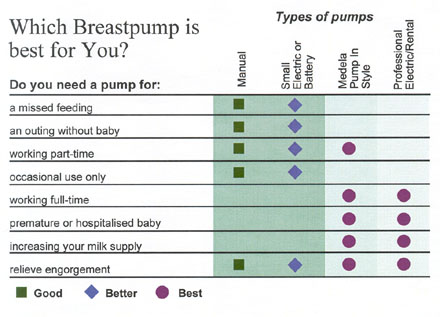A breast pump is not an essential tool to breastfeeding.
Most breastfeeding mothers do not need a breast pump. If breastfeeding is going well and you are not separated from your infant, there is no need for a breast pump. In need, it is important to realise that you already have everything you need to express your milk: your hands! When you need to express your milk temporarily or occasionally, hand expression is the first choice, because it is efficient, requires no equipment, no expenditure and no maintenance. It is an easily and quickly acquired skill. Before you leave the hospital, ask a Lactation Consultant (IBCLC) or a nurse to teach you this simple technique. Hand expression is actually the most efficient and least wasteful method of expressing colostrum during the early days, when required.
Why could you need a breast pump?
Temporary use of a breast pump could be indicated to relieve engorgement, when breasts are so distended that the baby is unable to latch on, and when you are separated from your baby for short periods on an occasional basis.
Long-term use of a breast pump is recommended when a mother wants to provide breastmilk for her premature or ill infant, until breastfeeding can be initiated or resumed. Long-term milk expression is also indicated when mother and baby are separated for long periods, when the mother returns to work, to increase milk production or induce lactation for an adopted baby.
It is important to seek advice from a skilled professional, such as a Certified Lactation Consultant (IBCLC), when you are considering the use of a breast pump.
How do I choose a breast pump?
All breast pumps are not equal. It is important to choose a pump that is designed specifically for your needs.
Features to look for in a safe and efficient breast pump:
- Automatic cycling: The length of each suction-release cycle should be pre-set, not user-dependant. This is essential to avoid injury to nipple and areolar tissue, as well as to deeper breast tissue. Some pumps have variable cycling, operating within safe limits.
- Minimum cycling speed between 40 and 60 cycles per minute, and suction pressure between 80 and 250 mm Hg. This is what makes a breast pump more or less able to reproduce the stimulation of your baby. To ensure comfort, the breast pump should have variable suction pressure levels.
- Easy to clean.
- All other features (single/double expression, portability, power source, etc.) are relative to your individual needs (use, budget, time).




